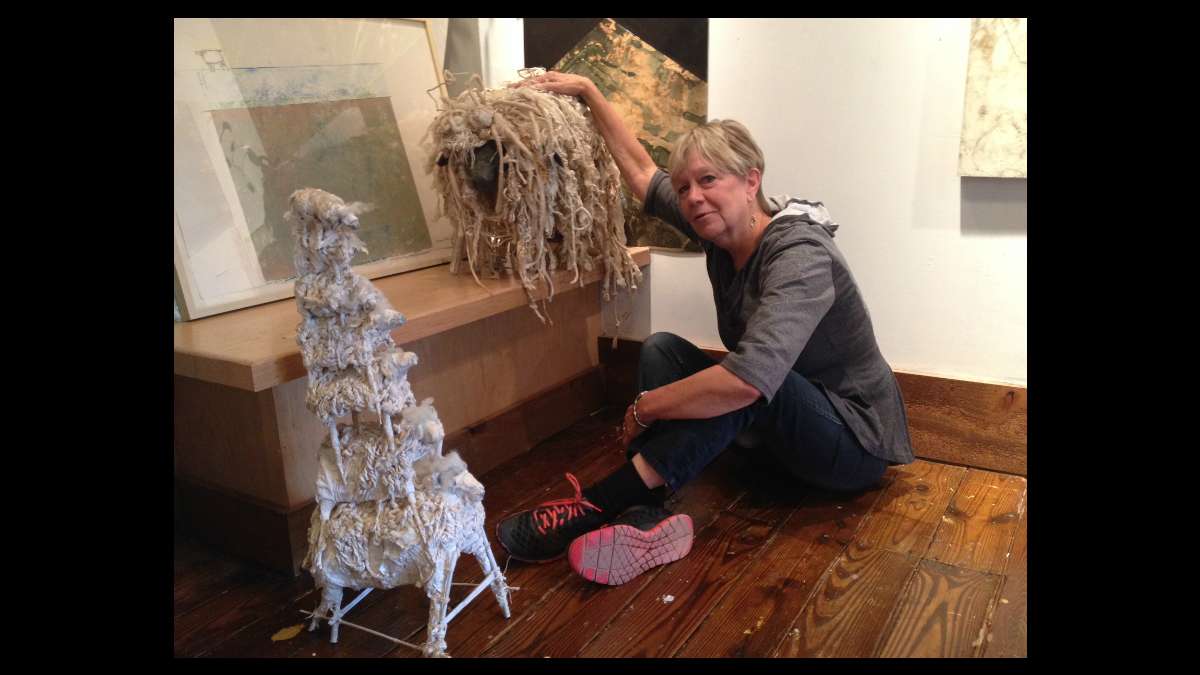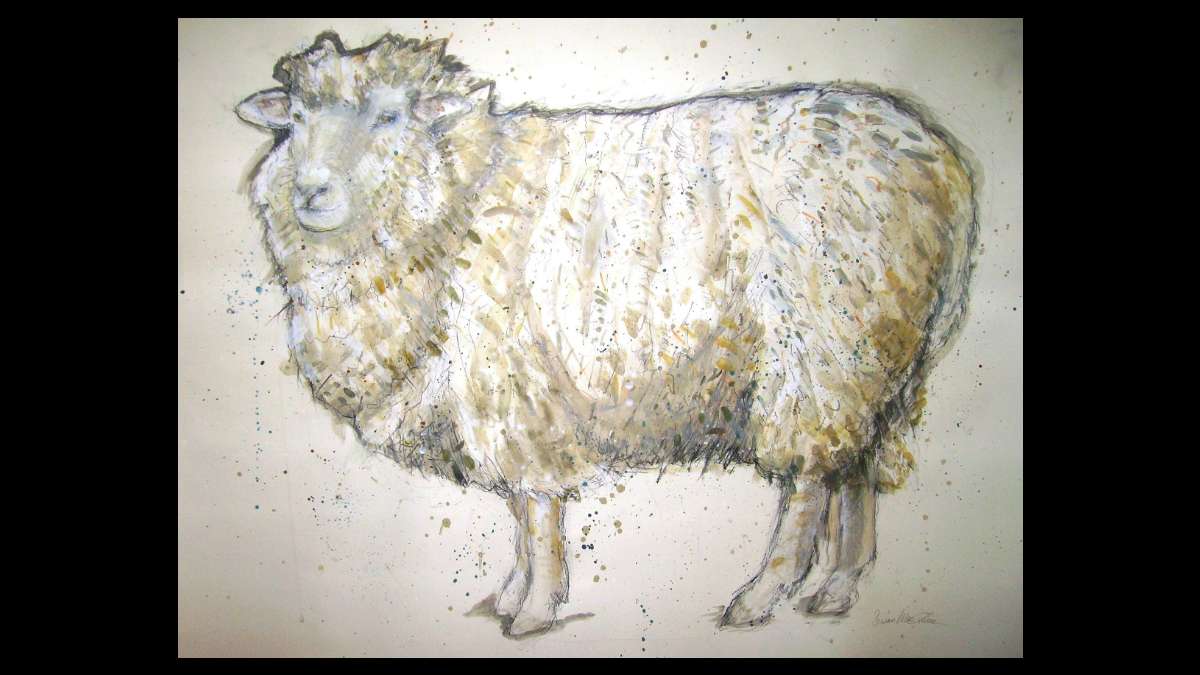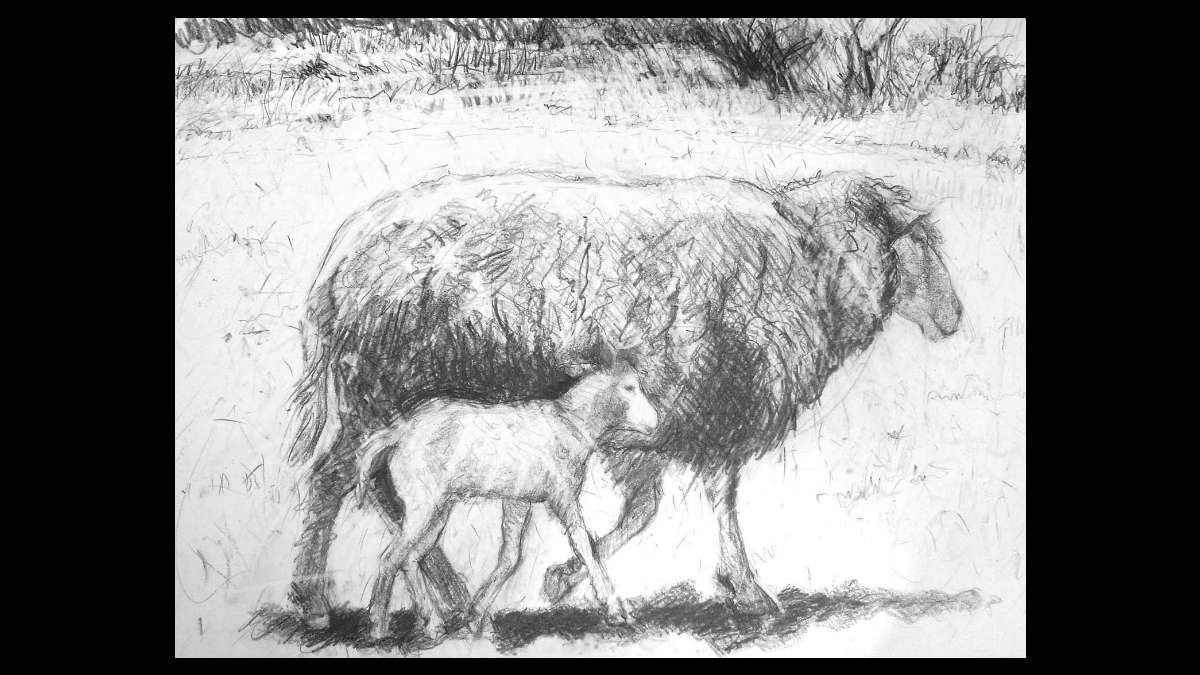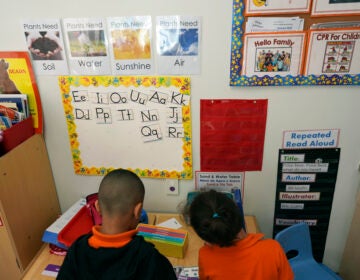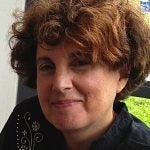Exhibit proves that not all sheep look the same
Susan MacQueen’s studio is in the repurposed chicken coops at Highland Design Farm on Van Dyke Road in Hopewell, NJ. “It’s friendly and lively here, with other artists for inspiration,” said MacQueen, whose work can be seen in two Princeton-area exhibits: Animal Nature at Art Times Two Gallery at Princeton Brain and Spine through March 2016, and monoprints on view at the Princeton Public Library, along with work by Hannah Fink, through January 17, 2016. Both MacQueen and Fink will give a gallery talk on Monday, November 16, 7-9 p.m.
Entering her studio, MacQueen greets the space by saying – “Hello” – as if it’s a being, and indeed there are presences in her gallery. Sheep that are simultaneously lifelike and fanciful are what MacQueen is known for.
The studio, with windows to another’s artist’s studio that have been covered with drapes, is like a mini museum of her work, and can be viewed by appointment throughout the year (e-mail susanmacqueen@yahoo.com). Working in this gallery-like setting enables MacQueen to see the interconnectedness of her output in different materials. “Sheep are still a big part of what I care about, they are object lessons and relate to what I’m working on in myself,” she said.
“Marshmallow” is a sheep to whom she’s given new ears and a simpler face. “Sewing is a relaxing way to revisit this art with craft,” said MacQueen, who has explored sheep through sculpture, installation, monoprint and drawing. Fleece, rope, ribbon, string, lace, mop heads and gesso are among the materials used to make the coats of the quadruped ruminant.
It began with collage, for which she had used glassine, natural fibers and string. “So I have this debris, and it was sitting on the table for a while, and I gathered them up to play with them and realized the materials looked like sheep,” she said.
“Sheep appeal to me as a model of cooperation, though not a perfect model. But they do a pretty good job. They remain in my thoughts because of the time we live in, and the flock is a model of living together, being different and getting along.”
Most people see sheep as dots on a pastoral landscape, but MacQueen wanted to bring out their rugged individuality. Using everything from felt, fringe, old T-shirts, fabric, grass, flowers, lace, paper and chenille robes to the bathroom rug, she weaves these around a frame made from fencing and wooden legs. “It’s put together with human will and glue.”
These are not stuffed animals you’d tuck under the covers with a sleeping child. “Sheep aren’t really fluffy,” she said. “They lie in dirt and stuff gets caught in their coat as a kind of diary of their experiences.”
In addition to three-dimensional work, MacQueen loves to draw, and has made intricate drawings of bovids. On a table is a taped-together drawing that looks like it could be a preliminary sketch, but in fact the drawings often come after the sculptural pieces. There are notes describing the flock: “This one wears his/her experience in her fleece.” “This one has a medusa like quality around the face.” “This one heavily gessoed canvas wrapped like Lazarus or home from the war.” “A bit like a puff ball, heavily ruffled, wool strips dipped in tea.”
Her favorite question is, “What would happen if…” For example, what would happen if sheep have human consciousness.
For her newest work, MacQueen went through the archives in her storage unit and excavated a hand-held sculpture. “I am still interested in that shape,” she said of her find. “I brought it out and used it as a basis for drawing. I traced around it, flying through turbulence.” It became a surreal figure of a woman floating in space with an orb. MacQueen is exploring an interest in Venetian plaster – “What would it be like to use shapes and press them into the plaster, to embed and excise,” she said. “I want to find a way of working with materials that is engaging, and investigate the forms in a different situation, reiterating an idea in a different way. Materials have voices.”
Venetian plaster “is more natural than brush strokes, and it goes into crevices. I’m interested in things that look like they are naturally occurring. It’s a time consuming process to create texture, it takes time to figure out where it wants to go, but it’s wonderful to have it to look at for a long time.” The result is contemporary imagery in an ancient material, like sgraffito or sprouting seeds.
MacQueen taught at Crossroads Nursery School for more than 20 years. “Working with little children reminds you of what’s important, and the value of play,” she said. “If you’re immersed in play, you don’t feel silly. We learn a lot being with children.
“Your values are poured into the things you stir up, and at this point of life I do have a point of view,” she continues. “I’m hoping the meek will inherit the earth – they are so everyman, my heart is with them.”
___________________________________________________________
The Artful Blogger is written by Ilene Dube and offers a look inside the art world of the greater Princeton area. Ilene Dube is an award-winning arts writer and editor, as well as an artist, curator and activist for the arts.
WHYY is your source for fact-based, in-depth journalism and information. As a nonprofit organization, we rely on financial support from readers like you. Please give today.


